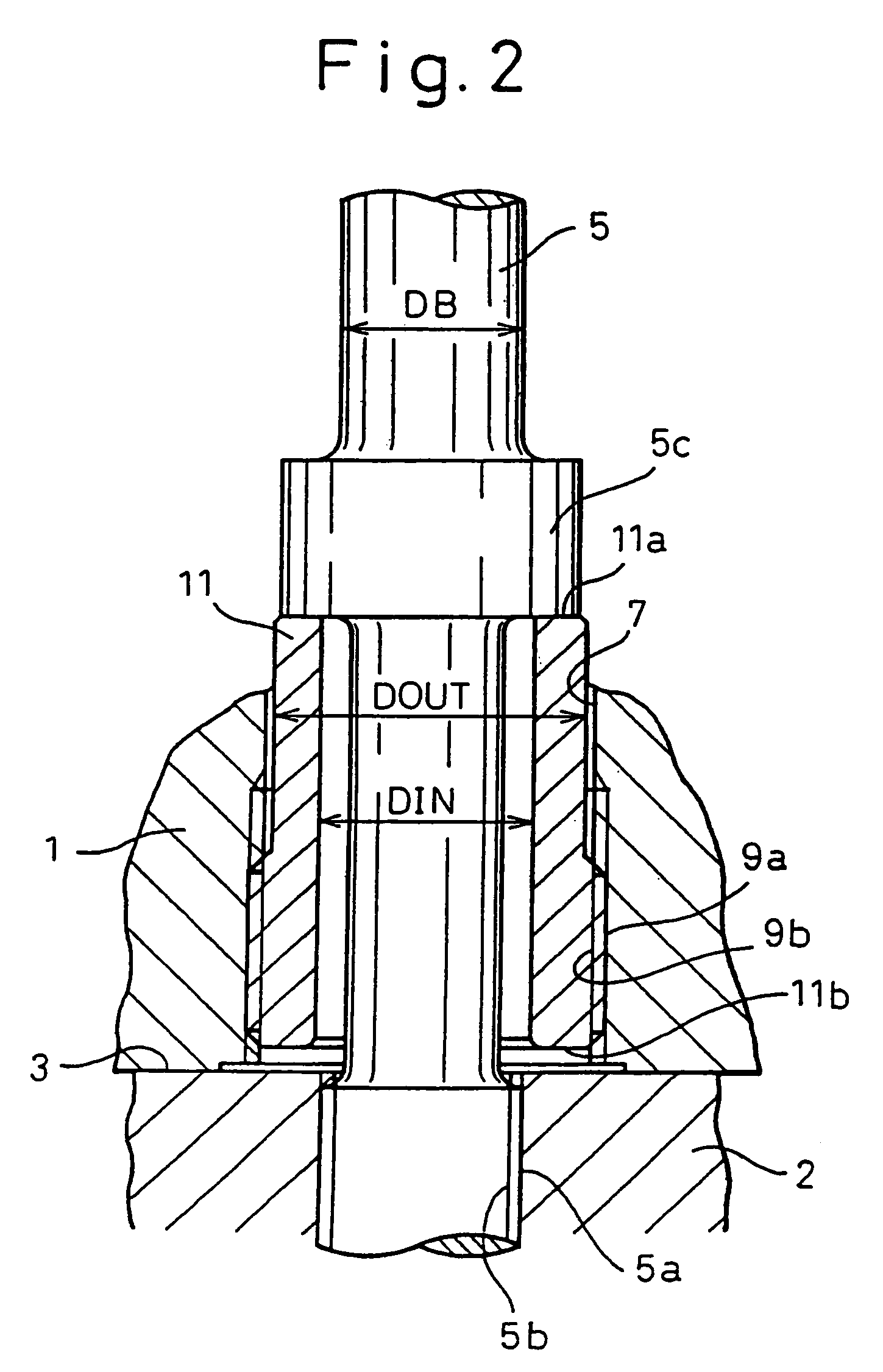Fastening arrangement for a split casing
- Summary
- Abstract
- Description
- Claims
- Application Information
AI Technical Summary
Benefits of technology
Problems solved by technology
Method used
Image
Examples
first embodiment
(1) First Embodiment
[0036]FIG. 1 illustrates a first embodiment of a fastening arrangement for a flangeless casing according to the present invention.
[0037]FIG. 1 is a sectional view of a casing of a gas turbine taken along the plane perpendicular to the center axis. The casing 10 of the gas turbine in FIG. 1 is constructed as a horizontally split type flangeless casing. More specifically the casing 10 in FIG. 1 is a cylindrical shape and split into two casing halves 1 and 2 by a plane including the center axis. The casing half 1 (hereinafter referred to as the “upper casing”) and the casing half 2 (hereinafter referred to as the “lower casing”) are coupled by joining joint faces 3 and fastened to each other firmly.
[0038]In FIG. 1, reference numeral 5 designates a plurality of fastening bolts for fastening the upper casing 1 and lower casing 2 together. In this embodiment, a screw thread 5a is formed at lower end portion of each fastening bolt 5. The fastening bolts 5 pass through b...
second embodiment
(2) Second Embodiment
[0055]FIG. 4 is a sectional view similar to FIG. 1 illustrating a second embodiment of the present invention. In FIG. 4, the reference numerals the same as those in FIG. 1 designate similar elements.
[0056]In this embodiment, a cylindrical sleeve similar to that in the first embodiment is used. However, although the sleeve 11 in the first embodiment is screwed into the bolt hole 7 from the joint face 3 side thereof, the sleeve 11 in this embodiment is screwed into the bolt hole 7 from the side thereof opposite to the joint face 3 and fitted inside the upper portion of the bolt hole 7. Further, the upper portion of the sleeve 11 protrudes from the bolt hole 7.
[0057]In this embodiment, an ordinary Allen screw the same as that in FIG. 8 is used in this embodiment. The diameter of the bolt head of an Allen screw is larger than the required diameter of the sleeve 11 as explained in the previous embodiment. Therefore, in order to avoid an increase in the diameter of th...
third embodiment
(3) Third Embodiment
[0058]FIG. 5 is sectional view similar to FIG. 1 but illustrating a third embodiment of the present invention. In FIG. 5, the reference numerals the same as those in FIGS. 1 and 2 designate similar elements.
[0059]In this embodiment, similar to the first embodiment, the sleeve 11 is screwed into the bolt hole 7 from the joint face 3 side. However, the shape of the bolt hole 7 in this embodiment is different from that of the first embodiment. Namely, the diameter of the bolt hole 7, is enlarged at the lower portion thereof in order to accommodate the sleeve 11 and the diameter of the bolt hole 7 at the upper portion thereof is reduced to a value slightly larger than the diameter of the shaft portion 5s of the fastening bolt 5.
[0060]In contrast with the first embodiment, in order to fastening the casing 10, the fastening bolt 5 is first inserted into the bolt hole 7 from the joint face 3 side, then, the sleeve 11 is screwed into the bolt hole 7 from the joint face 3...
PUM
| Property | Measurement | Unit |
|---|---|---|
| Force | aaaaa | aaaaa |
| Diameter | aaaaa | aaaaa |
| Length | aaaaa | aaaaa |
Abstract
Description
Claims
Application Information
 Login to View More
Login to View More - R&D
- Intellectual Property
- Life Sciences
- Materials
- Tech Scout
- Unparalleled Data Quality
- Higher Quality Content
- 60% Fewer Hallucinations
Browse by: Latest US Patents, China's latest patents, Technical Efficacy Thesaurus, Application Domain, Technology Topic, Popular Technical Reports.
© 2025 PatSnap. All rights reserved.Legal|Privacy policy|Modern Slavery Act Transparency Statement|Sitemap|About US| Contact US: help@patsnap.com



